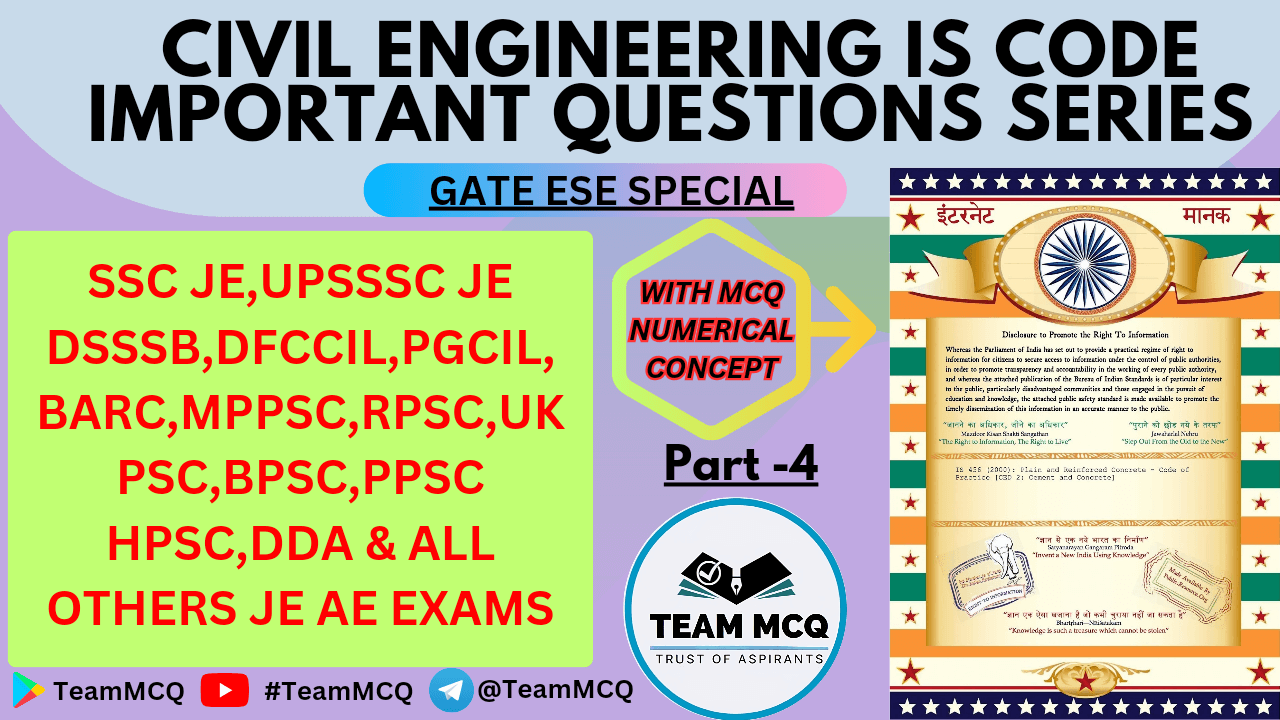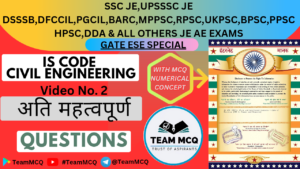IS code 1077:1992, Here are important one-liner questions related to the testing of bricks as per IS 1077:1992, presented in both Hindi and English.
1. IS 456:2000 important Questions in Civil Engineering
https://teammcq.com/is-code-important-questions-in-civil-engineering/
2. IS 516:1969 important Questions in Civil Engineering
https://teammcq.com/most-important-is-code-questions-in-civil-engineering/
3. IS 10262 important Questions in Civil Engineering
https://teammcq.com/civil-engineering-important-is-code-questions-by-teammcq/
🎞 IS CODE IMPORTANT QUESTIONS VIDEO PLAYLIST

General Overview / सामान्य अवलोकन
- What does IS 1077:1992 cover? / IS 1077:1992 में क्या शामिल है?
- Specifications for common burnt clay building bricks used in construction. / निर्माण में उपयोग होने वाली साधारण जली हुई मिट्टी की इमारती ईंटों के विनिर्देश।
- What is the primary use of bricks specified under IS 1077:1992? / IS 1077:1992 के तहत निर्दिष्ट ईंटों का प्राथमिक उपयोग क्या है?
- For general construction purposes where durability and strength are essential. / सामान्य निर्माण उद्देश्यों के लिए जहां स्थायित्व और ताकत आवश्यक है।
Dimensions / आयाम
- What are the standard dimensions of bricks as per IS 1077:1992? / IS 1077:1992 के अनुसार ईंटों के मानक आयाम क्या हैं?
- 190 mm x 90 mm x 90 mm or 190 mm x 90 mm x 40 mm. / 190 मिमी x 90 मिमी x 90 मिमी या 190 मिमी x 90 मिमी x 40 मिमी।
- What is the tolerance limit for the dimensions of bricks? / ईंटों के आयामों के लिए सहनशीलता सीमा क्या है?
- ±3% for length and ±2% for width and height. / लंबाई के लिए ±3% और चौड़ाई और ऊंचाई के लिए ±2%।
Physical Properties / भौतिक गुण
- What is the minimum compressive strength required for common bricks as per IS 1077:1992? / IS 1077:1992 के अनुसार साधारण ईंटों के लिए न्यूनतम संपीड़न शक्ति क्या आवश्यक है?
- 3.5 MPa. / 3.5 मेगापास्कल।
- How is the water absorption capacity of bricks tested? / ईंटों की जल अवशोषण क्षमता का परीक्षण कैसे किया जाता है?
- By immersing the brick in water for 24 hours and measuring the increase in weight. / ईंट को 24 घंटे के लिए पानी में डुबोकर और वजन में वृद्धि को मापकर।
- What is the maximum allowable water absorption for bricks? / ईंटों के लिए अधिकतम अनुमेय जल अवशोषण क्या है?
- 20% by weight for class 1 bricks. / वर्ग 1 ईंटों के लिए वजन के अनुसार 20%।
Testing Methods / परीक्षण विधियाँ
- How is the compressive strength of bricks tested? / ईंटों की संपीड़न शक्ति का परीक्षण कैसे किया जाता है?
- Using a compression testing machine by applying a load until the brick fails. / एक संपीड़न परीक्षण मशीन का उपयोग करके भार लागू करके जब तक ईंट फेल न हो जाए।
- What apparatus is used for determining the efflorescence of bricks? / ईंटों के सल्फाइड के लिए कौन सा उपकरण उपयोग किया जाता है?
- A shallow flat bottom dish and distilled water. / एक उथली सपाट तल की थाली और आसुत जल।
- How is the efflorescence of bricks assessed? / ईंटों के सल्फाइड का आकलन कैसे किया जाता है?
- By immersing half the depth of a brick in water and examining for white patches after drying. / आधी गहराई तक ईंट को पानी में डुबोकर और सूखने के बाद सफेद धब्बों की जांच करके।
Visual and Other Properties / दृश्य और अन्य गुण
- What should be the appearance of bricks as per IS 1077:1992? / IS 1077:1992 के अनुसार ईंटों की उपस्थिति कैसी होनी चाहिए?
- Uniform in shape and color with sharp edges and free from cracks. / आकार और रंग में एकसमान, तीखे किनारों वाले और दरारों से मुक्त।
- How are bricks classified based on their strength? / ईंटों को उनकी शक्ति के आधार पर कैसे वर्गीकृत किया जाता है?
- Based on the compressive strength into classes like 3.5, 5, 7.5, 10, 15, 20, 25, 30. / संपीड़न शक्ति के आधार पर जैसे 3.5, 5, 7.5, 10, 15, 20, 25, 30 वर्गों में।
- What is the permissible range for warpage in bricks? / ईंटों में तिरछापन के लिए अनुमेय सीमा क्या है?
- 3% of the actual size. / वास्तविक आकार का 3%।
- What is the relevance of soundness in bricks? / ईंटों में ध्वनि की प्रासंगिकता क्या है?
- Indicates the quality and uniformity of the brick material. / ईंट सामग्री की गुणवत्ता और एकरूपता को इंगित करता है।
- How is the soundness of bricks tested? / ईंटों की ध्वनि का परीक्षण कैसे किया जाता है?
- By striking two bricks together and listening for a clear ringing sound. / दो ईंटों को एक साथ मारकर और स्पष्ट घंटी की आवाज सुनकर।
Miscellaneous / विविध
- What are efflorescence categories as per IS 1077:1992? / IS 1077:1992 के अनुसार सल्फाइड की श्रेणियाँ क्या हैं?
- Nil, Slight, Moderate, Heavy, and Serious. / शून्य, हल्का, मध्यम, भारी, और गंभीर।
- How should bricks be stored on site as per IS 1077:1992? / IS 1077:1992 के अनुसार साइट पर ईंटों को कैसे संग्रहीत किया जाना चाहिए?
- In a manner to avoid damage and contact with water. / क्षति और पानी के संपर्क से बचने के लिए एक तरीके से।
- What is the importance of uniform size in bricks? / ईंटों के समान आकार का महत्व क्या है?
- Ensures ease of construction and consistent mortar joints. / निर्माण में आसानी और एकसमान मोर्टार जोड़ों को सुनिश्चित करता है।
- What is the significance of the efflorescence test? / सल्फाइड परीक्षण का महत्व क्या है?
- To check for soluble salts that can cause unsightly patches. / घुलनशील लवणों की जांच करने के लिए जो बदसूरत धब्बे पैदा कर सकते हैं।
- Why is compressive strength a critical property for bricks? / ईंटों के लिए संपीड़न शक्ति एक महत्वपूर्ण गुण क्यों है?
- It determines the load-bearing capacity of the brick. / यह ईंट की भार वहन क्षमता को निर्धारित करता है।
These questions cover the key aspects of brick testing as per IS 1077:1992, providing a comprehensive understanding of the standards and procedures in both Hindi and English.





Very interesting topic, appreciate it for posting.Raise range